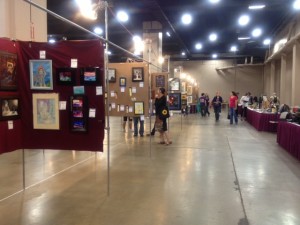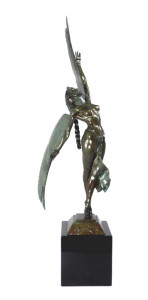
If you are a “crafter” – or better yet, a “craftsman” or “craftswoman” – then you’ve probably had to contend, at one point or another in your artistic career, with people who don’t think that what you’re creating is “real art”. That’s because people who “make things” – often utilitarian, with the focus on skilled handling of technique and materials – are not ranked as high on the totem pole of artistic worthiness as people who create things solely for the purpose of human “self-expression” or the experience of creating, alone.
You may dismiss this as fuzzy thinking, but it’s driven by our Western cultural bias toward separating “art” from craft” – which is how we get to the label “fine art”. The “Art vs. Craft” debate seems never-ending, because it hinges on an ever-evolving understanding of how we perceive what is considered “art”. I AM NOT INTERESTED in entering that debate; that’s not what this post is about. It doesn’t matter whether many artists (as well as collectors) believe the distinctions are illusiory, or not. The debate continues. What I am addressing here is that this ranking exists, persists, and affects the way we judge, and value, art created with sf/f themes or content.
The Hierarchal Distinction at SF Cons
Fan-run sf/fconventions do not make obvious efforts to distinguish “art” from “craft”. They don’t have to. All they have to do to influence our perceptions of “what is art” and persuade us that “crafts” are the lesser of artistic endeavors, is to offer artists panels for hanging “2-D” art and tables for “3-D” art. . . and then let nature (artists, and the way conventions are run) take its course, so to speak. My arguments here are based on my own observations of art shows over 30 + years. Your observations may differ from mine.
The first step is taken by artists themselves, who assume that if they are working in 3-D, they need to display their works on tables.

This is not strictly true, but that is the assumption that is made. That assumption, in turn, has real implications for the way an audience perceives the works, ie, as “lesser than” paintings (“art”) because of the differences in the way such art is presented. For example:
– tables for 3-D art are set up “to the side” or behind panels, or against the walls along the perimeter of the art show vs. panels “front and center” – “main attraction” – making art on them seem more important
– lighting is poorer for tables, because unlike for pegboard panels, extra lighting (If needed) cannot be attached to the frameworks
– unlike panels, “line of sight” set 4′ off the ground – tables are low, audience must bend down, work harder to see, examine, seek bid sheets, etc.
– the spacing between artists’ 3-D works are not well defined, as they are for panels. The table presentations are continuous displays, and ‘half table’ displays (2 artists per table) are possible. This amplifies the perception that such artists do not merit the distinction of being set apart, each from the other, as “special”.
– because the items in many cases are of lower sales value, and certainly smaller, than paintings…it encourages artists to display far more many items “per table” than can be displayed “per panel”. This creates a “flea market” sort of jumble in terms of visual effect, which affects viewers’ perceptions of “quality”
Perceptions of Ranking, and the Effects on Artists and Collectors

3-D artists tend to price works based on the amount of effort, time, and cost of materials put into their work- factors that don’t apply to “fine art.” These may be objective (the fluctuating price of gold or silver, or foundry costs for casting in bronze) but too often these factors are not well explained or understood. This is especially true when what is being valued is labor and ingenuity – and the cost of the goods is very low. As a result, the price/quality ratio is more confusing to buyers of 3-D art than for 2-D, and causes prospective buyers to believe it’s more capricious.
The perception that ‘arts’ are better than ‘crafts’ has also been influenced by art shows that allowed artists to label themselves as hobbyists, or “fan artists” (amateurs) or “professionals” (artists who earned a living as illustrators, as commercial artists) on bid sheets. Since this term had little meaning to most 3D artists, the only time prospective buyers saw this label it was attached to 2-D art.
In addition, the prospect of sales for higher-valued crafted art was low – for a variety of reasons –

compared to equivalently valued paintings and cast sculpture. Even under the best of circumstances, a collector able to afford a painting OR a work in porcelain valued at $500.00, very few would choose the ceramic work over the painting. This is borne out by my own experience in representing both 3-D and 2-D artists (including Clayborn Moore in the early 1990s); only about 5% of my clients would choose 3-D – regardless of price.
Partly this is a matter of education and exposure to the best of 3-D media. Many collectors have told me they simply don’t know how to display this kind of art, or judge the best of it. But the most important reason, and one they hesitate to discuss, is the purely economic one. There is no established secondary market in this field for 3-D genre works, regardless of medium, and given such poor prospects for recouping initial costs – buyers are wary of buying 3-D.
Add to that, a lack of recognition for the artists (no Hugo Awards for a 3-D or crafts artist as far as I know), and no incentive beyond outright sales to recoup the costs of showing their work (no prospect of jobs, commercial commissions like illustrators) and……many worthy 3-D Artists such as Clayburn Moore (www.csmoorestudio.com) and Bill Toma (www.fineart.com) stopped coming to sf cons. These artists come to mind as examples of those who would be the equivalent of professional artists working in 3-D media, but who did not get the same recognition, let alone be able to earn a living by showing their art at conventions. The point is, it was not until Moore established a studio to accept commercial commissions for licensed comic and action figures that he was really able to support himself as an artist. And those sorts of sculpts are not sold at sf/f art shows – perhaps in the dealer room, but not in the art show. Without a ‘top end’ in 3-D art it’s all either paintings, or crafts.
The Blurring of Distinctions Does Not Necessarily Improve the Situation
It was not entirely the fault of the convention environment that led fans to believe “arts are better than crafts” but nevertheless some artists figured that out early, and tried to overcome that perception by hanging (*suspending”) their 3-D works on panels. One of the first artists I can recall doing this was Charlene Taylor D’Alessio, with her hand-painted fantasy men’s ties. Nowadays, panel items run the gamut of artworks made from colored dryer lint, or feathers, and other “found” media to jewelry, painted silk scarves, quilts and eve – yes – embroidered dish towels. Indeed, there appears to have been a seismic shift, of late, in terms of what artists are opting for as their display mode “of choice”.
The void in professional artists who display their paintings at art shows is being filled by invitational displays (for example, the large display of original art by the late Darrell K. Sweet, at the last Worldcon) and young artists who do . . . what you would call “crafts” ….Will this “craft-heavy” kind of art show eliminate the bias against crafts? Or simply add to the general view that convention art shows are “in decline”???
Think carefully before you answer, because If that’s what you think, then you are (perhaps unwittingly) endorsing the continued ranking of crafts as “less worthy” than arts!
Next week:….I attack #2 of the Art Hierarchies…”Fine Art is Better than Illustrative (Commercial) Art” – so stay tuned! 🙂











1 Comment